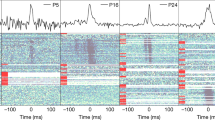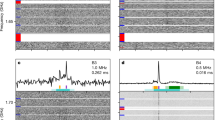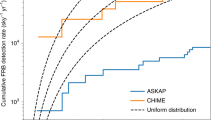Abstract
Intense, millisecond-duration bursts of radio waves (named fast radio bursts) have been detected from beyond the Milky Way1. Their dispersion measures—which are greater than would be expected if they had propagated only through the interstellar medium of the Milky Way—indicate extragalactic origins and imply contributions from the intergalactic medium and perhaps from other galaxies2. Although several theories exist regarding the sources of these fast radio bursts, their intensities, durations and temporal structures suggest coherent emission from highly magnetized plasma3,4. Two of these bursts have been observed to repeat5,6, and one repeater (FRB 121102) has been localized to the largest star-forming region of a dwarf galaxy at a cosmological redshift of 0.19 (refs. 7,8,9). However, the host galaxies and distances of the hitherto non-repeating fast radio bursts are yet to be identified. Unlike repeating sources, these events must be observed with an interferometer that has sufficient spatial resolution for arcsecond localization at the time of discovery. Here we report the localization of a fast radio burst (FRB 190523) to a few-arcsecond region containing a single massive galaxy at a redshift of 0.66. This galaxy is different from the host of FRB 121102, as it is a thousand times more massive, with a specific star-formation rate (the star-formation rate divided by the mass) a hundred times smaller.
This is a preview of subscription content, access via your institution
Access options
Access Nature and 54 other Nature Portfolio journals
Get Nature+, our best-value online-access subscription
$29.99 / 30 days
cancel any time
Subscribe to this journal
Receive 51 print issues and online access
$199.00 per year
only $3.90 per issue
Buy this article
- Purchase on Springer Link
- Instant access to full article PDF
Prices may be subject to local taxes which are calculated during checkout



Similar content being viewed by others
Data availability
The datasets generated during and/or analysed during this study are available from the corresponding author on reasonable request.
Code availability
Custom code is made available at https://github.com/VR-DSA.
References
Lorimer, D. R., Bailes, M., McLaughlin, M. A., Narkevic, D. J. & Crawford, F. A bright millisecond radio burst of extragalactic origin. Science 318, 777–780 (2007).
Petroff, E., Hessels, J. W. T. & Lorimer, D. R. Fast radio bursts. Astron. Astrophys. Rev. 27, 4 (2019).
Kumar, P., Lu, W. & Bhattacharya, M. Fast radio burst source properties and curvature radiation model. Mon. Not. R. Astron. Soc. 468, 2726–2739 (2017).
Metzger, B. D., Margalit, B. & Sironi, L. Fast radio bursts as synchrotron maser emission from decelerating relativistic blast waves. Mon. Not. R. Astron. Soc. 485, 4091–4106 (2019).
Spitler, L. et al. A repeating fast radio burst. Nature 531, 202–205 (2016).
The CHIME/FRB Collaboration. A second source of repeating fast radio bursts. Nature 566, 235–238 (2019).
Chatterjee, S. et al. A direct localization of a fast radio burst and its host. Nature 541, 58–61 (2017).
Marcote, B. et al. The repeating fast radio burst FRB 121102 as seen on milliarcsecond angular scales. Astrophys. J. 834, L8 (2017).
Bassa, C. et al. FRB 121102 is coincident with a star-forming region in its host galaxy. Astrophys. J. 843, L8 (2017).
Chambers, K. C. et al. The Pan-STARRS1 surveys. Preprint at https://arxiv.org/abs/1612.05560 (2016).
Oke, J. B. et al. The Keck low-resolution imaging spectrometer. Publ. Astron. Soc. Pacif. 107, 375–385 (1995).
Leja, J. & Johnson, B. D. bd-j/prospector: initial release. Zenodo https://doi.org/10.5281/zenodo.1116491 (2017).
Leja, J., Johnson, B. D., Conroy, C., van Dokkum, P. G. & Byler, N. Deriving physical properties from broadband photometry with rrospector: description of the model and a demonstration of its accuracy using 129 galaxies in the local Universe. Astrophys. J. 837, 170 (2017).
Rosa-González, D., Terlevich, E. & Terlevich, R. An empirical calibration of star formation rate estimators. Mon. Not. R. Astron. Soc. 332, 283–295 (2002).
Yan, R. et al. On the origin of [O II] emission in red-sequence and poststarburst galaxies. Astrophys. J. 648, 281–298 (2006).
Cordes, J. M. & Lazio, T. J. W. NE2001. I. A new model for the galactic distribution of free electrons and its fluctuations. Preprint at http://arxiv.org/abs/astroph/0207156 (2002).
Prochaska, J. X. & Zheng, Y. Probing galactic haloes with fast radio bursts. Mon. Not. R. Astron. Soc. 485, 648–665 (2019).
Eftekhari, T. & Berger, E. Associating fast radio bursts with their host galaxies. Astrophys. J. 849, 162 (2017).
Shull, J. M. & Danforth, C. W. The dispersion of fast radio bursts from a structured intergalactic medium at redshifts z < 1.5. Astrophys. J. 852, L11 (2018).
Shull, J. M., Smith, B. D. & Danforth, C. W. The baryon census in a multiphase intergalactic medium: 30% of the baryons may still be missing. Astrophys. J. 759, 23 (2012).
McQuinn, M. Locating the “missing” baryons with extragalactic dispersion measure estimates. Astrophys. J. 780, L33 (2014).
Ravi, V. The observed properties of fast radio bursts. Mon. Not. R. Astron. Soc. 482, 1966–1978 (2019).
Shannon, R. M. et al. The dispersion-brightness relation for fast radio bursts from a wide-field survey. Nature 562, 386–390 (2018).
Bhat, N. D. R., Cordes, J. M., Camilo, F., Nice, D. J. & Lorimer, D. R. Multifrequency observations of radio pulse broadening and constraints on interstellar electron density microstructure. Astrophys. J. 605, 759–783 (2004).
Vedantham, H. K. & Phinney, E. S. Radio wave scattering by circumgalactic cool gas clumps. Mon. Not. R. Astron. Soc. 483, 971–984 (2019).
Metzger, B. D., Berger, E. & Margalit, B. Millisecond magnetar birth connects FRB 121102 to superluminous supernovae and long-duration gamma-ray bursts. Astrophys. J. 841, 14 (2017).
Lyutikov, M. Coherence constraints on physical parameters at bright radio sources and FRB emission mechanism. Preprint at https://arxiv.org/abs/1901.03260 (2019).
Piro, A. L. & Kollmeier, J. A. Ultrahigh-energy cosmic rays from the “en caul” birth of magnetars. Astrophys. J. 826, 97 (2016).
Ruiter, A. J. et al. On the formation of neutron stars via accretion-induced collapse in binaries. Mon. Not. R. Astron. Soc. 484, 698–711 (2019).
Giacomazzo, B. & Perna, R. Formation of stable magnetars from binary neutron star mergers. Astrophys. J. 771, L26 (2013).
Kocz, J. et al. DSA-10: a prototype array for localizing fast radio bursts. Preprint at https://arxiv.org/abs/1906.08699 (2019).
Barsdell, B. R., Bailes, M., Barnes, D. G. & Fluke, C. J. Accelerating incoherent dedispersion. Mon. Not. R. Astron. Soc. 422, 379–392 (2012).
Cordes, J. M. & McLaughlin, M. A. Searches for fast radio transients. Astrophys. J. 596, 1142–1154 (2003).
Hickish, J. et al. A decade of developing radio-astronomy instrumentation using CASPER open-source technology. J. Astron. Instrum. 5, 1641001 (2016).
Condon, J. J. et al. The NRAO VLA Sky Survey. Astron. J. 115, 1693–1716 (1998).
Thompson, A. R., Moran, J. M. & Swenson, G. W. Jr Interferometry and Synthesis in Radio Astronomy 3rd edn (Springer, 2017).
Clark, M. A., LaPlante, P. C. & Greenhill, L. J. Accelerating radio astronomy cross-correlation with graphics processing units. Int. J. High Perform. Comput. Appl. 27, 178–192 (2013).
Sault, R. J., Teuben, P. J. & Wright, M. C. H. A retrospective view of MIRIAD. In Astronomical Data Analysis Software and Systems IV, ASP Conf. Ser. vol. 77 (eds Shaw, R. A et al.) 433 (1995).
Perley, D. A. Fully-automated reduction of longslit spectroscopy with the low resolution imaging spectrometer at Keck Observatory. Preprint at https://arxiv.org/abs/1903.07629 (2019).
Bertin, E. Automatic astrometric and photometric calibration with SCAMP. In Astronomical Data Analysis Software and Systems XV, ASP Conf. Ser. vol. 351 (eds Gabriel, C. et al.) 112 (2006).
Bertin, E. et al. The TERAPIX pipeline. In Astronomical Data Analysis Software and Systems XI, ASP Conf. Proc. vol. 281 (eds Bohlender, D. A. et al.) 228 (2002).
Bertin, E. & Arnouts, S. SExtractor: software for source extraction. Astron. Astrophys. Suppl. Ser. 117, 393–404 (1996).
Conroy, C., Gunn, J. E. & White, M. The propagation of uncertainties in stellar population synthesis modeling. I. The relevance of uncertain aspects of stellar evolution and the initial mass function to the derived physical properties of galaxies. Astrophys. J. 699, 486–506 (2009).
Conroy, C. & Gunn, J. E. The propagation of uncertainties in stellar population synthesis modeling. III. Model calibration, comparison, and evaluation. Astrophys. J. 712, 833–857 (2010).
Barbary, K. extinction v0.3.0. Zenodo https://doi.org/10.5281/zenodo.804967 (2016).
Foreman-Mackey, D., Hogg, D. W., Lang, D. & Goodman, J. emcee: the MCMC hammer. Publ. Astron. Soc. Pacif. 125, 306 (2013).
Murphy, D. & Lacy, M. VLA sky survey. https://science.nrao.edu/science/surveys/vlass (2019).
Planck Collaboration. Planck 2015 results. XIII. Cosmological parameters. Astron. Astrophys. 594, A13 (2016).
Acknowledgements
We thank the staff of the Owens Valley Radio Observatory, including J. Lamb, K. Hudson, A. Rizo and M. Virgin, for their assistance with the construction of the DSA-10. We thank A. Readhead for supporting the initiation of the DSA-10 project. We also thank A. Soliman for assistance with the development of the DSA-10 receivers. A portion of this research was performed at the Jet Propulsion Laboratory, California Institute of Technology, under a President and Directors Fund grant and under a contract with the National Aeronautics and Space Administration (NASA). This research was additionally supported by the National Science Foundation (NSF) under grant AST-1836018. V.R. acknowledges support as a Millikan Postdoctoral Scholar in Astronomy at the California Institute of Technology, and from a Clay Postdoctoral Fellowship of the Smithsonian Astrophysical Observatory. S.G.D. acknowledges partial support from NSF grant AST-1815034 and NASA grant 16-ADAP16-0232. Some of the data presented herein were obtained at the W. M. Keck Observatory, which is operated as a scientific partnership among the California Institute of Technology, the University of California and NASA. The Observatory was made possible by the financial support of the W. M. Keck Foundation. This research made use of Astropy, a community-developed core Python package for astronomy. The Pan-STARRS1 Surveys (PS1) and the PS1 public science archive have been made possible through contributions by the Institute for Astronomy, the University of Hawaii, the Pan-STARRS Project Office, the Max-Planck Society and its participating institutes, the Max-Planck Institute for Astronomy, Heidelberg, the Max-Planck Institute for Extraterrestrial Physics, Garching, Johns Hopkins University, Durham University, the University of Edinburgh, Queen’s University Belfast, the Harvard-Smithsonian Center for Astrophysics, the Las Cumbres Observatory Global Telescope Network Incorporated, the National Central University of Taiwan, the Space Telescope Science Institute, NASA under grant NNX08AR22G issued through the Planetary Science Division of the NASA Science Mission Directorate, NSF grant AST-1238877, the University of Maryland, Eotvos Lorand University, the Los Alamos National Laboratory, and the Gordon and Betty Moore Foundation.
Author information
Authors and Affiliations
Contributions
G.H., V.R. and H.K.V. conceived of and developed the DSA-10 concept and observing strategy. V.R., J.K. and S.R.K. led the construction and initial deployment of DSA-10. D.P.W., S.W, L.D., J.K., V.R., H.K.V, M.C., R.H. and J.S. designed and built the DSA-10 subsystems. V.R. and H.K.V. commissioned the DSA-10. V.R. operated the DSA-10 and analysed the data. S.G.D. carried out the optical observations. V.R. analysed the optical data, and led the writing of the manuscript with the assistance of all co-authors.
Corresponding author
Ethics declarations
Competing interests
The authors declare no competing interests.
Additional information
Publisher’s note: Springer Nature remains neutral with regard to jurisdictional claims in published maps and institutional affiliations.
Peer review information Nature thanks Shami Chatterjee and Jason Hessels for their contribution to the peer review of this work.
Extended data figures and tables
Extended Data Fig. 1 DSA-10 images.
Dirty and deconvolved images are shown of two bright point-sources and FRB 190523. All data were obtained at the same hour angle relative to the meridian, within 12 h of each other. The same calibration solution, derived using the J1200 + 7300 data, was applied to all data. The black crosses indicate the known source positions in the top and middle rows, and the best-fit position of FRB 190523 in the bottom row. The recovery of the correct position of J1927 + 7358 at the hour angle that FRB 190523 was detected at demonstrates the accuracy of the calibration solutions.
Extended Data Fig. 2 Visibility phases measured for two bright point-sources and FRB 190523.
Only data on baselines including fully functioning antennas are shown. The visibility data were phase-rotated to the known (or best-fit for FRB 190523) source positions, and averaged across the frequency band. Data on the shortest baselines (to the left of the dashed vertical line) were corrupted by correlated noise, and were discarded from imaging analysis. All data were calibrated using the same calibration solution, which was partially based on the J1200 + 7300 data, and were obtained at the same hour angle relative to the meridian within a 12-h timeframe. The x axis shows the baseline lengths in units of wavelengths at the middle of the DSA-10 frequency band.
Extended Data Fig. 3 Recovered positions of J1927 + 7358 on 12 separate days.
Each position was derived from 5 min of visibility data, extracted when J1927 + 7358 was at the same hour angle as FRB 190523 was detected. On each day, the data were also calibrated in exactly the same way as the FRB 190523 data. The error bars indicate the 68% (1σ) confidence intervals for the estimated positions.
Rights and permissions
About this article
Cite this article
Ravi, V., Catha, M., D’Addario, L. et al. A fast radio burst localized to a massive galaxy. Nature 572, 352–354 (2019). https://doi.org/10.1038/s41586-019-1389-7
Received:
Accepted:
Published:
Issue Date:
DOI: https://doi.org/10.1038/s41586-019-1389-7
This article is cited by
-
Variable Chaplygin gas: Constraining parameters using FRBs
Astrophysics and Space Science (2024)
-
Cosmology with fast radio bursts in the era of SKA
Science China Physics, Mechanics & Astronomy (2023)
-
Repeating fast radio bursts: Coherent circular polarization by bunches
Science China Physics, Mechanics & Astronomy (2022)
-
The evolution of binary neutron star post-merger remnants: a review
General Relativity and Gravitation (2021)
-
Testing fundamental physics with astrophysical transients
Frontiers of Physics (2021)
Comments
By submitting a comment you agree to abide by our Terms and Community Guidelines. If you find something abusive or that does not comply with our terms or guidelines please flag it as inappropriate.



